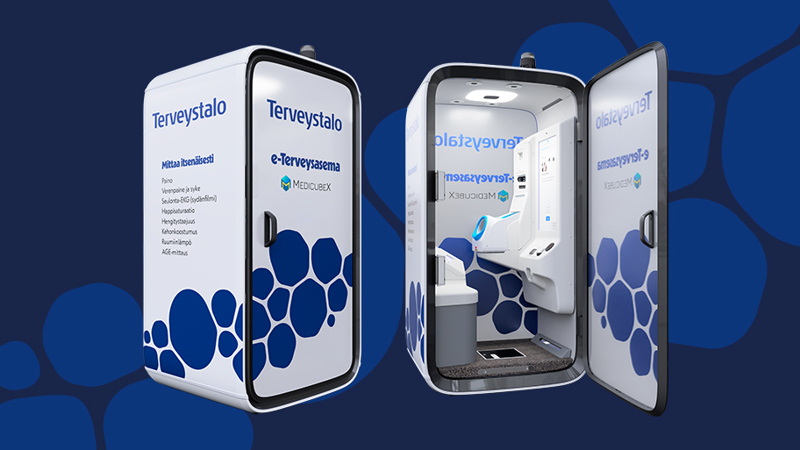An efficient or a humanely efficient organization? A well-functioning organization requires both kinds of efficiency
An organization is efficient when it takes into account both operational and humane efficiency in its operations. Humane efficiency takes people’s psychological needs into consideration – and that is why it is worth putting its ideas into practice now.

Operational efficiency, which ensures both the efficiency and the performance of the company, is a familiar concept for many in management roles.
On the other hand, humane efficiency is overlooked in too many organizations. Humane efficiency describes the psychological dynamics and human factors of an organization: how, for example, a sense of community is realized within the organization and how the people working in the organization can be motivated.
Outi Ikonen, Terveystalo’s Chief Organizational Psychologist, points out that an organization that strives for efficiency should invest in both operational and humane efficiency.
“Without one there cannot be the other. Taking humane efficiency into account increases the growth of the organization’s productivity, the success of various changes and the well-being of employees,” says Ikonen.
The world is changing – pay attention to how changes are made
Adopting the ideas of humane efficiency is particularly useful when changes are being made.
“For example, uncertainty has increased enormously during the COVID-19 crisis, and it is now even more important to take human factors into account. If no attention is paid to human factors, efficiency will definitely not increase and may even decrease,” says Ikonen.
According to Ikonen, the success of various organizational changes also depends to a large extent on how well humane efficiency is realized within the organization.
“The change process can be very good in terms of operational efficiency, but if humane efficiency is not taken into account, employees will not be motivated and, at worst, trust will be undermined.”
The step toward humane efficiency does not have to be taken alone.
“The goal of the Humane Efficiency coaching offered by Terveystalo is to increase the organization’s competence in managing human factors and, through that, improve the entire organization’s productivity and the well-being of its employees,” Outi Ikonen says.
The management’s example matters
Building a healthy and humane organization starts with the senior management clarifying the target situation.
“Supervisors should be aware of the effects of humane efficiency, but the actions of the management team are particularly important. If the senior management does not make a strong commitment to the issue and act as an agent of change, humane efficiency will not be improved,” Ikonen says.
The process itself is not always easy. In order for an organization to develop, the management needs a genuine understanding of the current state of the organization’s humane efficiency and the target situation toward which it intends to proceed.
“Organizations often invest in well-being at work, but the projects end up being too unconnected. In order for humane efficiency to become a reality, it is important that good practices are properly embedded in the culture and structures of the organization. In this way, they will eventually become the actual common practices of the organization,” Ikonen says.
Five steps toward a humanely efficient workplace
- Let humanity show. Be yourself. If you work in a supervisory role, it is good to think about how much you can let your feelings show. However, keep in mind that supervisors and managers have their own strengths and vulnerabilities, which should not be hidden unnecessarily.
- Remember balance. Lead change, inspire, and encourage, while also ensuring sufficient internal stability, routines, and smoothness of work.
- Boldly combine humane and operational leadership. A good manager of people can also be an excellent manager of performance at the same time. Humane efficiency and operational efficiency are not mutually exclusive.
- Learn to understand. Listen to and understand not only things but also people’s experiences and feelings. A leader should use their own example to create a psychologically safe work community in which asking, wondering and mistakes are allowed.
- Set an example. Set limits that support well-being for yourself and others and ensure a good work–life balance. Supervisors should keep in mind that if they work too hard, they will set an example for employees that they should work just as hard. At worst, overachievement undermines humane efficiency.
Learn more about Humane Efficiency
Lue lisää aiheesta

Investments in technological development support Terveystalo's effective occupational health activities
Technological development and digitalization are fundamentally changing work: routine tasks are being automated, knowledge-based decision-making is accelerating, and people's roles are increasingly focused on creativity, problem-solving, and developing the customer experience. At Terveystalo, technology is seen as a strategic enabler that can be used to support the smooth running of corporate customers' everyday operations and create a foundation for even more effective occupational health services. Our vision for the future is to be a pioneer in the digitalization and effectiveness of occupational health services.

Flu season has begun: 7 tips how doctors prevent the flu
The common cold is prevalent in Finland throughout the year. However, viruses spread more readily in the fall, and the influenza season typically begins at the end of the year.

Näin Suomi voi: The decline in mental health-related sick leaves continues to accelerate
At Terveystalo, we committed at the beginning of the year to reduce mental health-related sick leave by 5% among our current customer base during 2025. This ambitious reduction target has progressed excellently during the first half of the year, with the reduction already almost doubling the target. This excellent result has been driven by the development of mental health services for occupational health customers and close cooperation with our corporate customers.

The future of work is built on curiosity and amazement – this is how you can boost your learning efficiency
The future working life will challenge our brains in entirely new ways. Organizations and individuals will have to adapt to constant change, where learning, sharing information, and utilizing diverse thinking will take center stage. It is no longer enough to master a single skill thoroughly; curiosity, the ability to innovate, and the skill to creatively combine different perspectives are also required. According to brain researcher Katri Saarikivi, cognitively stimulating work improves brain health, as long as organizations manage to ensure that the workload does not become too heavy.

Nicotine satches and e-cigarettes already pose a threat to oral health
Nicotine sachets use is increasing, especially among working-age men and women. Among young people, e-cigarette smoking has even tripled in five years. It is already known that nicotine sachets and e-cigarettes cause similar changes in the mouth as traditional smoking. Ritva Lindblad, senior dentist at Terveystalo, warns that we are only now beginning to see the first signs of the products' effects on oral health.

Terveystalo strengthens disease prevention in collaboration with Finnish health technology company MedicubeX
Terveystalo and the Finnish health technology company MedicubeX have entered into a strategic partnership that will make Terveystalo the only private healthcare provider in Finland to have access to MedicubeX's self-monitoring stations (e-Health Stations™). The aim of the partnership is to support the health of the Finnish population and prevent lifestyle diseases.